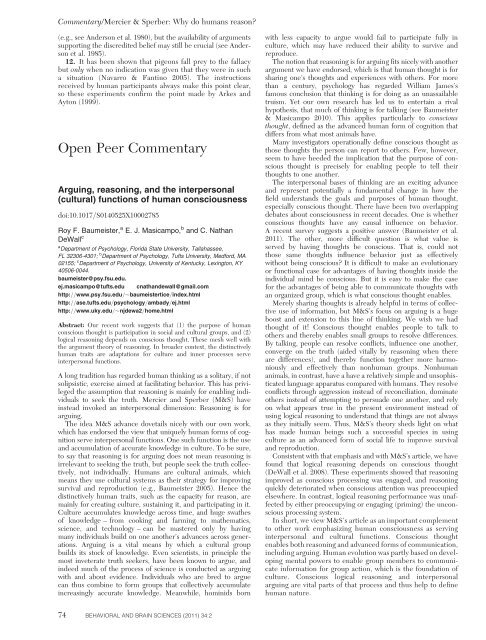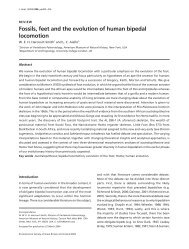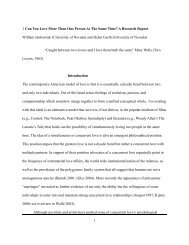Why do humans reason? Arguments for an argumentative theory
Why do humans reason? Arguments for an argumentative theory
Why do humans reason? Arguments for an argumentative theory
Create successful ePaper yourself
Turn your PDF publications into a flip-book with our unique Google optimized e-Paper software.
Commentary/Mercier & Sperber: <strong>Why</strong> <strong>do</strong> <strong>hum<strong>an</strong>s</strong> <strong>reason</strong>?(e.g., see Anderson et al. 1980), but the availability of argumentssupporting the discredited belief may still be crucial (see Andersonet al. 1985).12. It has been shown that pigeons fall prey to the fallacybut only when no indication was given that they were in sucha situation (Navarro & F<strong>an</strong>tino 2005). The instructionsreceived by hum<strong>an</strong> particip<strong>an</strong>ts always make this point clear,so these experiments confirm the point made by Arkes <strong>an</strong>dAyton (1999).Open Peer CommentaryArguing, <strong>reason</strong>ing, <strong>an</strong>d the interpersonal(cultural) functions of hum<strong>an</strong> consciousness<strong>do</strong>i:10.1017/S0140525X10002785Roy F. Baumeister, a E. J. Masicampo, b <strong>an</strong>d C. Nath<strong>an</strong>DeWall ca Department of Psychology, Florida State University, Tallahassee,FL 32306-4301; b Department of Psychology, Tufts University, Med<strong>for</strong>d, MA02155; c Department of Psychology, University of Kentucky, Lexington, KY40506-0044.baumeister@psy.fsu.edu.ej.masicampo@tufts.edu cnath<strong>an</strong>dewall@gmail.comhttp://www.psy.fsu.edu/≏baumeistertice/index.htmlhttp://ase.tufts.edu/psychology/ambady/ej.htmlhttp://www.uky.edu/≏njdewa2/home.htmlAbstract: Our recent work suggests that (1) the purpose of hum<strong>an</strong>conscious thought is participation in social <strong>an</strong>d cultural groups, <strong>an</strong>d (2)logical <strong>reason</strong>ing depends on conscious thought. These mesh well withthe argument <strong>theory</strong> of <strong>reason</strong>ing. In broader context, the distinctivelyhum<strong>an</strong> traits are adaptations <strong>for</strong> culture <strong>an</strong>d inner processes serveinterpersonal functions.A long tradition has regarded hum<strong>an</strong> thinking as a solitary, if notsolipsistic, exercise aimed at facilitating behavior. This has privilegedthe assumption that <strong>reason</strong>ing is mainly <strong>for</strong> enabling individualsto seek the truth. Mercier <strong>an</strong>d Sperber (M&S) haveinstead invoked <strong>an</strong> interpersonal dimension: Reasoning is <strong>for</strong>arguing.The idea M&S adv<strong>an</strong>ce <strong>do</strong>vetails nicely with our own work,which has en<strong>do</strong>rsed the view that uniquely hum<strong>an</strong> <strong>for</strong>ms of cognitionserve interpersonal functions. One such function is the use<strong>an</strong>d accumulation of accurate knowledge in culture. To be sure,to say that <strong>reason</strong>ing is <strong>for</strong> arguing <strong>do</strong>es not me<strong>an</strong> <strong>reason</strong>ing isirrelev<strong>an</strong>t to seeking the truth, but people seek the truth collectively,not individually. Hum<strong>an</strong>s are cultural <strong>an</strong>imals, whichme<strong>an</strong>s they use cultural systems as their strategy <strong>for</strong> improvingsurvival <strong>an</strong>d reproduction (e.g., Baumeister 2005). Hence thedistinctively hum<strong>an</strong> traits, such as the capacity <strong>for</strong> <strong>reason</strong>, aremainly <strong>for</strong> creating culture, sustaining it, <strong>an</strong>d participating in it.Culture accumulates knowledge across time, <strong>an</strong>d huge swathesof knowledge – from cooking <strong>an</strong>d farming to mathematics,science, <strong>an</strong>d technology – c<strong>an</strong> be mastered only by havingm<strong>an</strong>y individuals build on one <strong>an</strong>other’s adv<strong>an</strong>ces across generations.Arguing is a vital me<strong>an</strong>s by which a cultural groupbuilds its stock of knowledge. Even scientists, in principle themost inveterate truth seekers, have been known to argue, <strong>an</strong>dindeed much of the process of science is conducted as arguingwith <strong>an</strong>d about evidence. Individuals who are bred to arguec<strong>an</strong> thus combine to <strong>for</strong>m groups that collectively accumulateincreasingly accurate knowledge. Me<strong>an</strong>while, hominids bornwith less capacity to argue would fail to participate fully inculture, which may have reduced their ability to survive <strong>an</strong>dreproduce.The notion that <strong>reason</strong>ing is <strong>for</strong> arguing fits nicely with <strong>an</strong>otherargument we have en<strong>do</strong>rsed, which is that hum<strong>an</strong> thought is <strong>for</strong>sharing one’s thoughts <strong>an</strong>d experiences with others. For moreth<strong>an</strong> a century, psychology has regarded William James’sfamous conclusion that thinking is <strong>for</strong> <strong>do</strong>ing as <strong>an</strong> unassailabletruism. Yet our own research has led us to entertain a rivalhypothesis, that much of thinking is <strong>for</strong> talking (see Baumeister& Masicampo 2010). This applies particularly to consciousthought, defined as the adv<strong>an</strong>ced hum<strong>an</strong> <strong>for</strong>m of cognition thatdiffers from what most <strong>an</strong>imals have.M<strong>an</strong>y investigators operationally define conscious thought asthose thoughts the person c<strong>an</strong> report to others. Few, however,seem to have heeded the implication that the purpose of consciousthought is precisely <strong>for</strong> enabling people to tell theirthoughts to one <strong>an</strong>other.The interpersonal bases of thinking are <strong>an</strong> exciting adv<strong>an</strong>ce<strong>an</strong>d represent potentially a fundamental ch<strong>an</strong>ge in how thefield underst<strong>an</strong>ds the goals <strong>an</strong>d purposes of hum<strong>an</strong> thought,especially conscious thought. There have been two overlappingdebates about consciousness in recent decades. One is whetherconscious thoughts have <strong>an</strong>y causal influence on behavior.A recent survey suggests a positive <strong>an</strong>swer (Baumeister et al.2011). The other, more difficult question is what value isserved by having thoughts be conscious. That is, could notthose same thoughts influence behavior just as effectivelywithout being conscious? It is difficult to make <strong>an</strong> evolutionaryor functional case <strong>for</strong> adv<strong>an</strong>tages of having thoughts inside theindividual mind be conscious. But it is easy to make the case<strong>for</strong> the adv<strong>an</strong>tages of being able to communicate thoughts with<strong>an</strong> org<strong>an</strong>ized group, which is what conscious thought enables.Merely sharing thoughts is already helpful in terms of collectiveuse of in<strong>for</strong>mation, but M&S’s focus on arguing is a hugeboost <strong>an</strong>d extension to this line of thinking. We wish we hadthought of it! Conscious thought enables people to talk toothers <strong>an</strong>d thereby enables small groups to resolve differences.By talking, people c<strong>an</strong> resolve conflicts, influence one <strong>an</strong>other,converge on the truth (aided vitally by <strong>reason</strong>ing when thereare differences), <strong>an</strong>d thereby function together more harmoniously<strong>an</strong>d effectively th<strong>an</strong> nonhum<strong>an</strong> groups. Nonhum<strong>an</strong><strong>an</strong>imals, in contrast, have a have a relatively simple <strong>an</strong>d unsophisticatedl<strong>an</strong>guage apparatus compared with <strong>hum<strong>an</strong>s</strong>. They resolveconflicts through aggression instead of reconciliation, <strong>do</strong>minateothers instead of attempting to persuade one <strong>an</strong>other, <strong>an</strong>d relyon what appears true in the present environment instead ofusing logical <strong>reason</strong>ing to underst<strong>an</strong>d that things are not alwaysas they initially seem. Thus, M&S’s <strong>theory</strong> sheds light on whathas made hum<strong>an</strong> beings such a successful species in usingculture as <strong>an</strong> adv<strong>an</strong>ced <strong>for</strong>m of social life to improve survival<strong>an</strong>d reproduction.Consistent with that emphasis <strong>an</strong>d with M&S’s article, we havefound that logical <strong>reason</strong>ing depends on conscious thought(DeWall et al. 2008). These experiments showed that <strong>reason</strong>ingimproved as conscious processing was engaged, <strong>an</strong>d <strong>reason</strong>ingquickly deteriorated when conscious attention was preoccupiedelsewhere. In contrast, logical <strong>reason</strong>ing per<strong>for</strong>m<strong>an</strong>ce was unaffectedby either preoccupying or engaging (priming) the unconsciousprocessing system.In short, we view M&S’s article as <strong>an</strong> import<strong>an</strong>t complementto other work emphasizing hum<strong>an</strong> consciousnessasservinginterpersonal <strong>an</strong>d cultural functions. Conscious thoughtenables both <strong>reason</strong>ing <strong>an</strong>d adv<strong>an</strong>ced <strong>for</strong>ms of communication,including arguing. Hum<strong>an</strong> evolution was partly based on developingmental powers to enable group members to communicatein<strong>for</strong>mation <strong>for</strong> group action, which is the foundation ofculture. Conscious logical <strong>reason</strong>ing <strong>an</strong>d interpersonalarguing are vital parts of that process <strong>an</strong>d thus help to definehum<strong>an</strong> nature.74 BEHAVIORAL AND BRAIN SCIENCES (2011) 34:2




